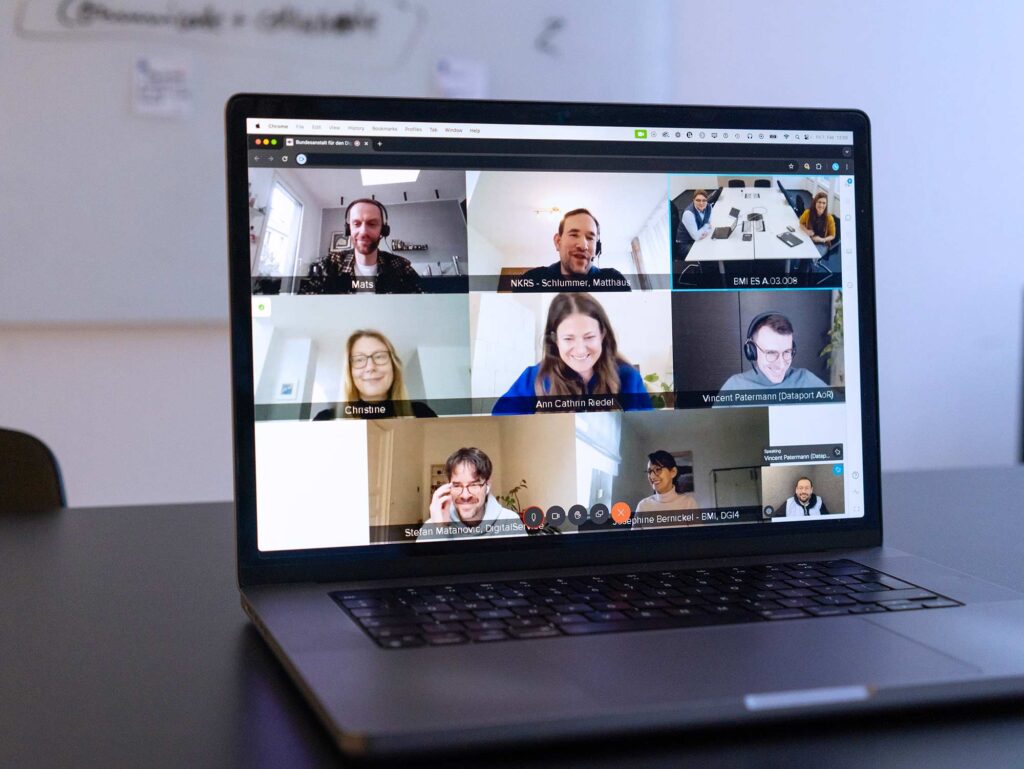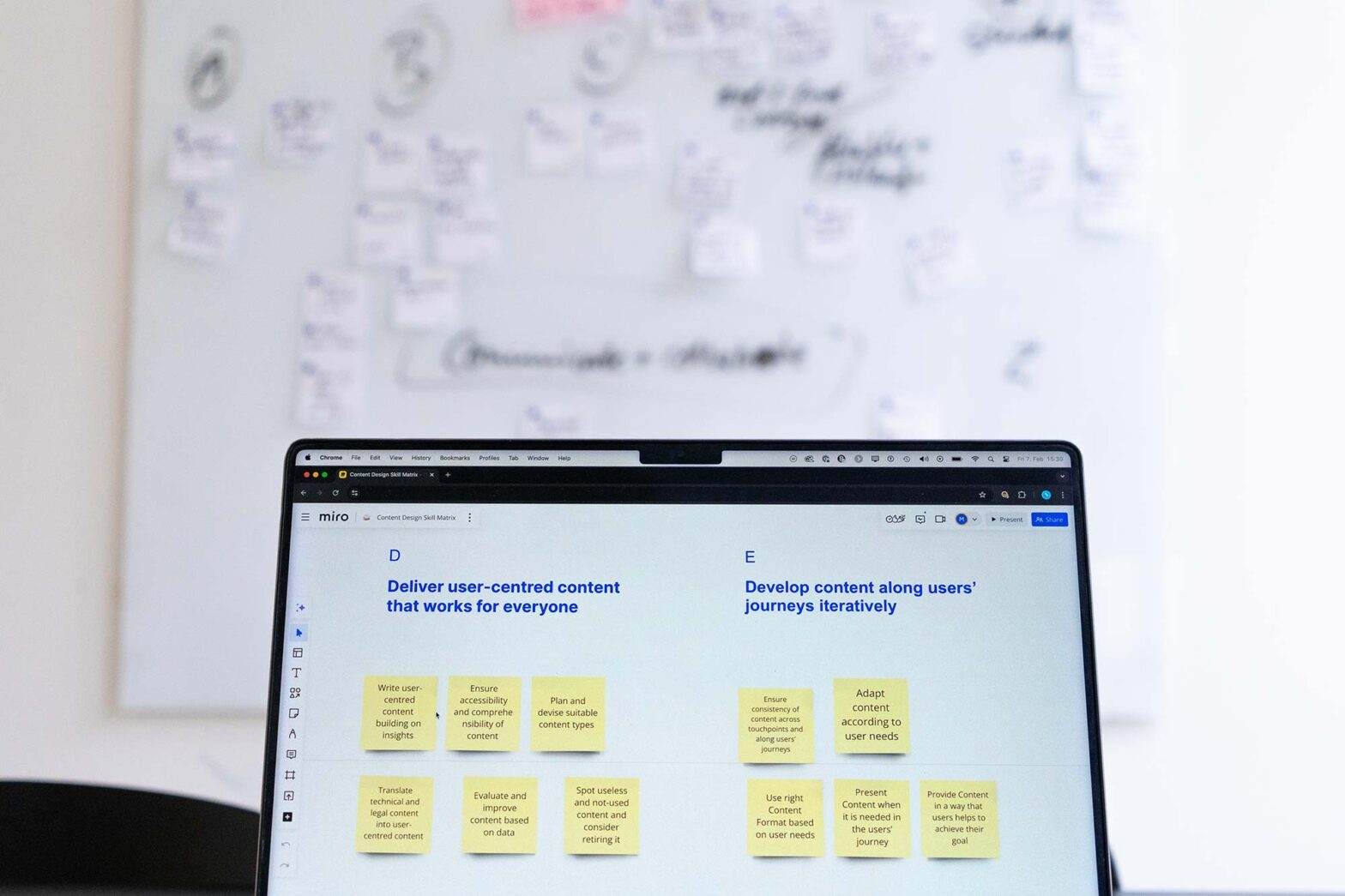Focus time is sometimes the best time. On Wednesday, Thursday and Friday, Torsten and I carved out time in the afternoon to develop the first draft of the content design skill matrix. We made some good progress. But we are far from being done.
I had hoped that our UK colleagues had already progressed in their capability framework. However, there has been no update to the content designer level description on the Government Digital and Data Profession Capability Framework since 2021. In the meantime, the design and user research level descriptions received an update just a few weeks ago. The UK cross-gov content design folks are just getting started, it appears.
Drafting a content design skill framework
We have had a skill framework for user experience and user interface design since early 2023. Since the summer of 2024, we have also had one for user research. That leaves about 23% of our user-centred design colleagues uncovered. Neither content nor communication design has a substantial description of the skills and experiences they should have at what level. As the next bigger discipline, Torsten and I reserved time to take a first tab on it.
From the start, we wanted the structure to follow the existing skill frameworks for the other sub-disciplines. There, we have 12 skills in 4 skill areas. Half of the skill areas and skills inside are similar to almost identical – grouped as ‘communicate and collaborate’ and ‘supporting people and change’. We focussed on the remaining other half first.
In 2 workshop sessions, we collected activities and higher-level tasks of content designers. To get started, we skipped the levels of complexity along seniority, wrote and . Our skill framework describes the 12 skills on ‘awareness’, ‘working’, ‘practitioner’, and ‘expert’ level. We will get to the differentiation in a bit.
Our first draft of skill headings include:
- Identify and evaluate existing content with a focus on users
- Plan and conduct content-focussed research activities
- Synthesize findings and translate insights into opportunities
- Deliver user-centred content that works for everyone
- Develop content along users’ journeys iteratively
- Establish standards and processes for good content creation
These points will change. Things might be missing. And we will rewrite and refine them.
In the coming 2 weeks, we should finish a solid version that is good enough to share with all content designers at Digital Service for review. And I will also let my UK colleagues take a look.
Then, I swiftly will have to continue with the communication design skill matrix. Eventually, I want us to publish all of our skill matrices for user-centred design roles either on GitHub, OpenCode or as part of the updated Service Standard manual. These materials should be valuable for other digital units across government, too.
Plotting the path forward for the updated Service Standard
After a little break, the Service Standard sounding board got together again. They received an update on all the things that happened in recent weeks and what’s left to make the updated standard mandatory. It was a highly appreciative hour.

Otherwise, in the Service Standard team, we tried to figure out where Service Standard, its manual and other touchpoints should live and how they best interrelate with each other. We sketched timelines until summer and also looked at technical setups.
To stretch out our necks and link things up, we also had an exchange with Isabell from KERN Design System on how things they do overlap with what we do and plan to do. There are plenty of overlaps, and KERN today includes guidance that could similarly sit in guidance close to the Service Standard. We plan to have further collaboration sessions shortly.
Wrapping up Demo Day
The comms team is finishing the final Demo Day activities. Some team members are just recovering from the intensity of the efforts around it. The German public sector tech press covered the event quite extensively.
The videographer we worked with did a brilliant job dynamically capturing the afternoon and evening. The different formats are well visible, and our ministerial partners get a well-deserved spotlight.
You can see me nodding at time code 2:08.
Bianca, Robin and I ran a design-related retrospective for the event. There will be another extended round with the entire core team shortly.
Comparing possible pathways for digital government
What wild weeks in digital government! Have we ever seen more divergent approaches presented simultaneously? The second Trump presidency has fundamentally warped USDS—the highly respected United States Digital Service—into ‘DOGE’, the ‘Department of Government Efficiency’. At the same time, the UK government refreshed its vision with a ‘blueprint for modern digital government’. The views, values, and desired outcomes could not be more different.
The new US government fired federal workers working on improving the accessibility of public services and enhancing diversity, equity, and inclusion. They shut down government websites and unpublished vital data for public sector transparency and scientific research. They also rewrote the definition of a multidisciplinary team: now, it’s an attorney, an HR specialist, an engineer, and a ‘DOGE lead’. That’s the setup to check who can all be dismissed without critical infrastructure failing.
In the meantime, our UK colleagues plan “Public sector digital teams [to] have the skills and support they need to build services that better echo people’s lives and real-world experiences”. A new strategy envisions joined-up public services moving at the same pace as citizens’ lives. Public servants are asked to commit to transparency and drive accountability. This involves publishing and acting more on performance data and building necessary data infrastructure. The default mode to work on these things is “agile, user-centred, multidisciplinary teams”.
With a general election in Germany just weeks away, we must ask ourselves what take on digital government we want here—short- and mid-term. Do we want to see things radically disrupted or thoughtfully reformed? Do we want leaders who move fast and break things? Or leaders who move considerately yet are determined to transform things, focusing on societal outcomes and positive impact? Do we want to see the public sector workforce shrunk and outsourced or further capability built in-house? Do we want institutions dismantled and handed over to the private sector or rather administrative structures reformed and institutions strengthened and more capable?
‘Special government employee’ Musk calls it a “fork in the road”. One path leads to deconstruction, the other to renewal and construction. Collectively, in a democracy, we decide.
Many international colleagues are concerned about what they have seen in the past few days. They fear this might become a blueprint for more countries to follow.
In April, public sector colleagues from across Europe and around the world will come together to discuss how to make our governments work better for their people. Hosted by Dutch Gebruiker Centraal community, we will gather at the User Needs First conference from 9–11 April in Amsterdam. I look forward to exchanges on where we are heading and how to help shape a good future.
What’s next
On Thursday next week, I will join a meeting of Sachsen-Anhalt’s Digital Council and give an input on user-centricity. I don’t know if the Ser
Before, I will support the ‘Introduction to Service Design’ training that Marco and Sabrina run on Tuesday and Wednesday as much as my calendar allows.

